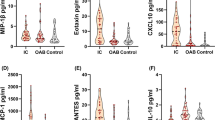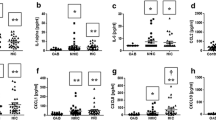Abstract
Purpose
To identify and quantify toxic urinary cations in male patients with bladder pain syndrome/interstitial cystitis versus male controls, to compare them in symptomatic patients to those significantly improved, and to evaluate cytotoxicity of these cations to cultured urothelial cells to determine whether Tamm-Horsfall protein (THP) can neutralize the cations.
Methods
Isolation of cationic fraction (CFs) was achieved by solid phase extraction on urine specimens of 51 male patients with IC and 33 male controls. C18 reverse-phase high-performance liquid chromatography was used to profile and quantify cationic metabolites. Major CF peaks were identified by liquid chromatography–tandem mass spectrometry. HTB-4 urothelial cells were used to determine the cytotoxicity of CFs, individual metabolites, and of metabolite mixture with THP of patient versus THP of control subject.
Results
CF content was significantly higher in patients compared to controls (p < 0.001). Patients had higher levels of modified nucleosides, amino acids, and their derivatives compared to controls. Cytotoxicity for control versus patient mean (SEM) percent was 1.7 (2.9) % versus 63.0 (3.7) %, respectively, (p < 0.001). Cytotoxicity of metabolites was reduced in the presence of THP of control compared to THP of patient (p < 0.001).
Conclusions
Patients with IC had significantly higher levels of cationic metabolites with higher cytotoxicity compared to controls. THP of these patients had reduced ability to sequester cytotoxicity of cationic metabolites. Patients who significantly improved on therapy had the same levels and toxicity of cationic metabolites as symptomatic males, suggesting that these cations may be the cause of epithelial dysfunction in IC.



Similar content being viewed by others
References
Parsons CL, Albo M (2002) Intravesical potassium sensitivity in patients with prostatitis. J Urol 168:1054–1057
Hassan AA, Elgamal SA, Sabaa MA et al (2007) Evaluation of intravesical potassium sensitivity test and bladder biopsy in patients with chronic prostatitis/chronic pelvic pain syndrome. Int J Urol 14:738–742
Parsons CL (2011) The role of a leaky epithelium and potassium in the generation of bladder symptoms in interstitial cystitis/overactive bladder, urethral syndrome, prostatitis and gynaecological chronic pelvic pain. BJU Int 107:370–375. doi:10.1111/j.1464-410X.2010.09843.x
Parsons CL, Boychuk D, Jones S et al (1990) Bladder surface glycosaminoglycans: an epithelial permeability barrier. J Urol 143:139–142
Lilly JD, Parsons CL (1990) Bladder surface glycosaminoglycans is a human epithelial permeability barrier. Surg Gynecol Obstet 171:493–496
Parsons CL, Lilly JD, Stein P (1991) Epithelial dysfunction in nonbacterial cystitis (interstitial cystitis). J Urol 145:732–735
Parsons CL, Greenberger M, Gabal L et al (1998) The role of urinary potassium in the pathogenesis and diagnosis of interstitial cystitis. J Urol 159:1862–1866 (discussion 1866–1867)
Parsons CL, Stein PC, Bidair M et al (1994) Abnormal sensitivity to intravesical potassium in interstitial cystitis and radiation cystitis. Neurourol Urodyn 13:515–520
Parsons CL, Shaw T, Berecz Z et al (2014) Role of urinary cations in the aetiology of bladder symptoms and interstitial cystitis. BJU Int 114:286–293. doi:10.1111/bju.12603
Friedlander JI, Shorter B, Moldwin RM (2012) Diet and its role in interstitial cystitis/bladder pain syndrome (IC/BPS) and comorbid conditions. BJU Int 109:1584–1591. doi:10.1111/j.1464-410X.2011.10860.x
Erickson DR (2001) Urine markers of interstitial cystitis. Urology 57:15–21
Erickson DR, Tomaszewski JE, Kunselman AR et al (2008) Urine markers do not predict biopsy findings or presence of bladder ulcers in interstitial cystitis/painful bladder syndrome. J Urol 179:1850–1856. doi:10.1016/j.juro.2008.01.047
Kushner L, Chiu PY, Brettschneider N et al (2001) Urinary substance P concentration correlates with urinary frequency and urgency in interstitial cystitis patients treated with intravesical dimethyl sulfoxide and not intravesical anesthetic cocktail. Urology 57:129
Keay S, Zhang CO, Trifillis AL et al (1996) Decreased 3H-thymidine incorporation by human bladder epithelial cells following exposure to urine from interstitial cystitis patients. J Urol 156:2073–2078
Keay S, Reeder JE, Koch K et al (2007) Prospective evaluation of candidate urine and cell markers in patients with interstitial cystitis enrolled in a randomized clinical trial of Bacillus Calmette Guerin (BCG). World J Urol 25:499–504
Parsons CL, Bautista SL, Stein PC et al (2000) Cyto-injury factors in urine: a possible mechanism for the development of interstitial cystitis. J Urol 164:1381–1384
Parsons CL, Rajasekaran M, Arsanjani AH et al (2007) Role of sialic acid in urinary cytoprotective activity of Tamm-Horsfall protein. Urology 69:577–581
Stein P, Rajasekaran M, Parsons CL (2005) Tamm-Horsfall protein protects urothelial permeability barrier. Urology 66:903–907
Rajasekaran M, Stein P, Parsons CL (2006) Toxic factors in human urine that injure urothelium. Int J Urol 13:409–414
Argade SP, Vanichsarn C, Chenoweth M et al (2009) Abnormal glycosylation of Tamm Horsfall Protein in patients with interstitial cystitis. BJU Int 103:1085–1089. doi:10.1111/j.1464-410X.2008.08163.x
Parsons CL, Dell J, Stanford EJ et al (2002) Increased prevalence of interstitial cystitis: previously unrecognized urologic and gynecologic cases identified using a new symptom questionnaire and intravesical potassium sensitivity. Urology 60:573–578
Gillenwater JY, Wein AJ (1988) Summary of the National Institute of Arthritis, Diabetes, Digestive and Kidney Diseases Workshop on Interstitial Cystitis, National Institutes of Health, Bethesda, Maryland, August 28–29, 1987. J Urol 140:203–206
Gutsche B, Grun C, Scheutzow D et al (1999) Tryptophan glycoconjugates in food and human urine. Biochem J 343:11–19
Parsons CL, Benson G, Childs SJ et al (1993) A quantitatively controlled method to study prospectively interstitial cystitis and demonstrate the efficacy of pentosanpolysulfate. J Urol 150:845–848
Gillespie L (1993) Metabolic appraisal of the effects of dietary modification on hypersensitive bladder symptoms. Br J Urol 72:293–297
Kaufman JE, Anderson K, Parsons CL (1987) Inactivation of antiadherence effect of bladder surface glycosaminoglycans as possible mechanism for carcinogenesis. Urology 30:255–258
Akiyama A, Stein PC, Houshiar A et al (2000) Urothelial cytoprotective activity of Tamm-Horsfall protein isolated from the urine of healthy subjects and patients with interstitial cystitis. Int J Urol 7:176–183
Parsons CL, Proctor J, Teichman JS et al (2011) A multi-site study confirms abnormal glycosylation in the Tamm-Horsfall protein of patients with interstitial cystitis. J Urol 186:112–116. doi:10.1016/j.juro.2011.02.2699
Parsons CL, Stein P, Zupkas P et al (2007) Defective Tamm-Horsfall protein in patients with interstitial cystitis. J Urol 178:2665–2670
Author information
Authors and Affiliations
Corresponding author
Rights and permissions
About this article
Cite this article
Argade, S., Berecz, Z., Su, Y. et al. Increased toxic urinary cations in males with interstitial cystitis: a possible cause of bladder symptoms. World J Urol 34, 1685–1691 (2016). https://doi.org/10.1007/s00345-016-1808-4
Received:
Accepted:
Published:
Issue Date:
DOI: https://doi.org/10.1007/s00345-016-1808-4




